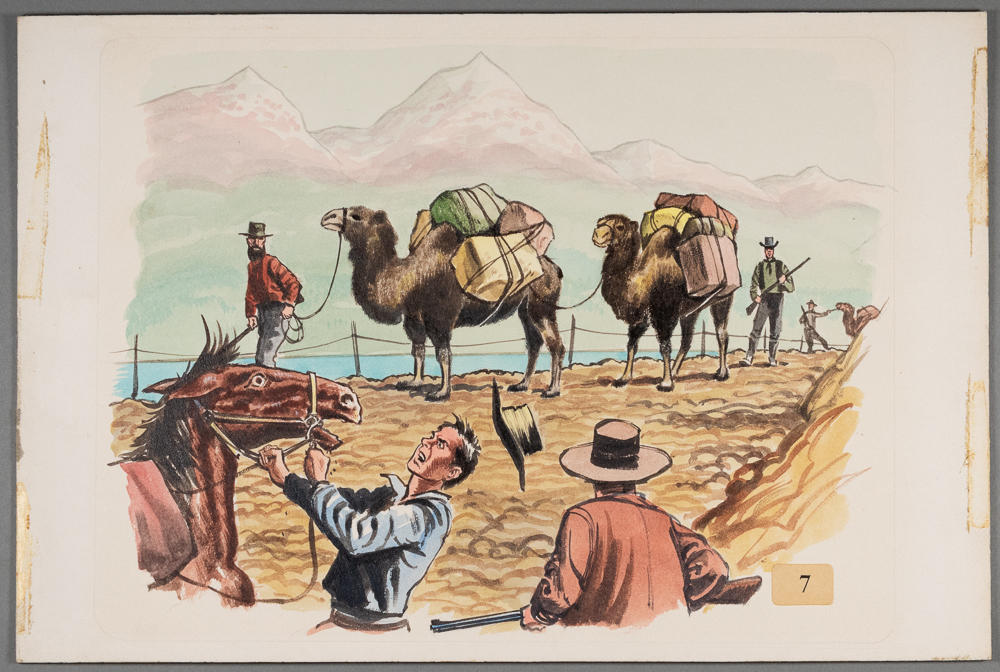The British Colonist – March 1, 1862, p3

The “Camels” Are Coming
Twenty-five dromedaries are advertised for
sale by Mr. Walton. A chance is thus offered
Cariboo packers to obtain animals suited to
their purpose at a low figure. The advantages
possessed by the camels over all other pack
animals are too well known to require a
newspaper “puff,” but their great
recommendation to Cariboo packers appears
to be their long legs, which will enable them to
breast deep snow-drifts, the merest sight of
which would disturb the equanimity of
strongest-nerved or best-conducted jackass
in British Columbia. After the camels have
been disposed of and started for the mines
with the first load, we learn that a number of trained whales will be placed on the route between Victoria and Strickeen River, carrying freight and inside passengers a la Joshua at reduced rates.
The British Colonist – March 14, 1962, p 3
The Camels
Mr John Colbraith of Lillooet is the party who purchased the 23 dromedaries at San Francisco. The price paid was $300 and they will be used to pack goods from Lillooet to Cariboo. Each animal will carry at least 500 pounds easily. They are from Armoor River, and a number were in constant use in the Washoe country last summer, where they are said to have thriven well. Mr. C. is confident he has secured a bargain and expects them here on the 15th of April.
The British Colonist, April 15, 1862, p3
The Camels Have Come
Mr. Golbreath’s twenty-three Bactrian camels arrived on the Hermann yesterday. They are singular looking animals, and when driven from the steamer frightened the horse at Esquimalt out of their propriety and a week’s appetite. The animals are just now engaged in shedding the winter’s coat of hair and present a very scaly appearance. Each has two humps on the back and will pack from 500 to 600 pounds. A practical test of their availability as pack animals in British Columbia will be made in a few days. The strangers, who are guarded by live Turks, are at the Half-Way House.
The British Colonist, April 25, 1862, p3
Who Is She?
The mysterious female who delights to exhibit her fair proportions in male attire and rejoice in her ability to ride in public astraddle of a horse is reported to have been seen again on the Esquimalt road yesterday. She was attired in a light cashmere coat, knee breeches and a high black hat. Her long hair was very neatly turned under. Accompanying the mysterious female was another feminine, who seemed to possess a little more modesty – not to mention decency – than her companion, and sported a lady’s black riding habit. The pair visited the camels, and it was while they were inspecting the little stranger which came to town the other night that the gait and carriage of the disguised female betrayed her sex to several bystanders. After spending a few minutes with the camels, they re-mounted their steeds and rode leisurely into town. Who they were, or where they came from is a mystery, but the one in breeches is said to be the lady who astonished the Esquimalters by her appearance among them in a similar costume about two weeks ago.
Colonist May 2, 1862 page 3
The Camels were brought to town yesterday and herded in a lot at the corner of Douglas and Johnson street.
The British Colonist, May 3, 1862, p3.
Way, She Spat!
Yesterday morning we strolled to the corner of Douglas and Johnson streets and nanicked the camels. About twenty persons on a like errand were standing about the lot, poking fun and sticks at the symmetrically formed and noble-looking beasts, and among other we noticed a gaily dressed young stranger who seemed particularly interested in the baby camel and its fond mamma. To evince the lively and affectionate regard which he entertained for the parent and her lovely offspring, the stranger would occasionally drag the latter by the tail some distance from its mother; then he would put his arm around its neck and hug it until it was nearly strangled; next he would beat it with a small cane, and so he kept up his attentions until the poor little animal, annoyed beyond endurance, sought refuge between its mother’s feet. The young man next turned his attention to the mother, sized her by the tail, poked her with a long stick, and kicked he on the feet and legs. All these delicate little attentions her Camelship stood without seeming to notice save by an occasional low snort or a change of position, until finally her tormentor became bolder and ventured to place his hand upon the animal’s snout and force her head up and down like the handle of an old-fashioned town pump. Indiscreet man! He paid dearly for his temerity – it was the “ last feather that broke the camel’s back,” for, rendered furious by the indignities practiced upon her, the beast quickly raised her head to a level with her tormentor’s eyes, and, with a noise resembling the rush of a full head of steam from a boiler, forced through her nostrils about two gallons of dirty water – pumped up from the secret repository, which all respectable camels possess, especially for the stranger’s benefit and instruction. The poor fellow, surprised, alarmed, and quite blinded for the moment by the unexpected visitation, sought refuge in flight and as quickly as possible placed the fence between himself and the enraged beast, who followed and nearly succeeded in giving him a second dose before he got beyond her reach. Arrived on the opposite side of the fence, and looking mean enough to sell out for two bits, the stranger drew a delicately perfumed handkerchief from his pocket and after wiping the water from his face, eyes and shirt-bosom, looked around on the roaring crowd of spectators, and making a sickly attempt to look unconcerned, with a woe-stricken grin on his countenance, he remarked “Why she spits like a steam-injun,” and sneaked off down Johnson street. The gallon or two of experience which that young fellow picked up from the poor camel, should last him through life.
The British Colonist, May 6, 1862, p 3
The Camels
Yesterday twenty-two of the camels were forwarded by the Enterprise to New Westminster. They will be passed over the Harrison- Lillooet trail to Lillooet and from thence will start with the first load for Cariboo as soon as the trail is passable. A great diversity of opinion exists as to the adaptability of these animals for packing purposes in British Columbia, and the failure of a number who were tried in Washoe last year is quoted as proof of their inability to stand the climate or to traverse rugged mountain passes. The non-success of those tried at Washoe, we are assured, was owing to the alkali, which abounds in that section, rendering their feet sore, and not from the effects of the climate or the rugged character of the trails. The species are known as the Bactrian or two-humped camel and possess most of the characteristics of the Arabian or one-humped dromedary. They came from Amoor River, where they were used as pack animals, and they answered well. Whether they will answer the same purpose in the sister colony is an open question which can only be decided after a fair trial. The dam and her calf have been left behind until string enough to withstand the fatigue of a journey.
Colonist, Nov 24, 1862, p3
The Native Camel – The young camel born upon the island last spring is still wandering at large with its maternal “parient”. They were both seen along the Cadboro Bay Road in good health last Saturday.
